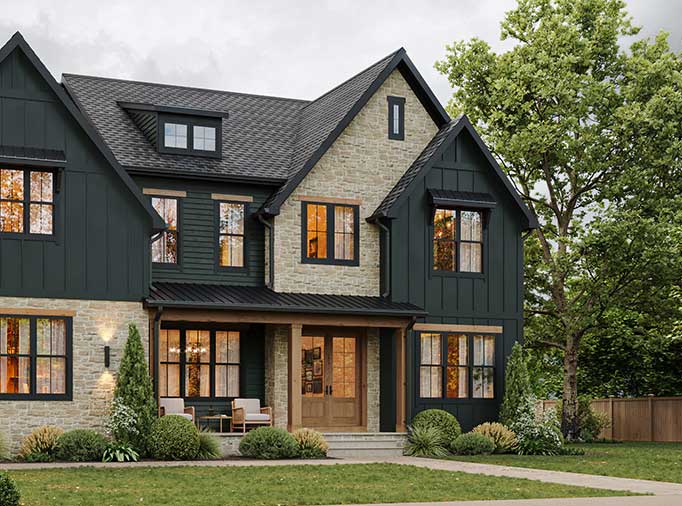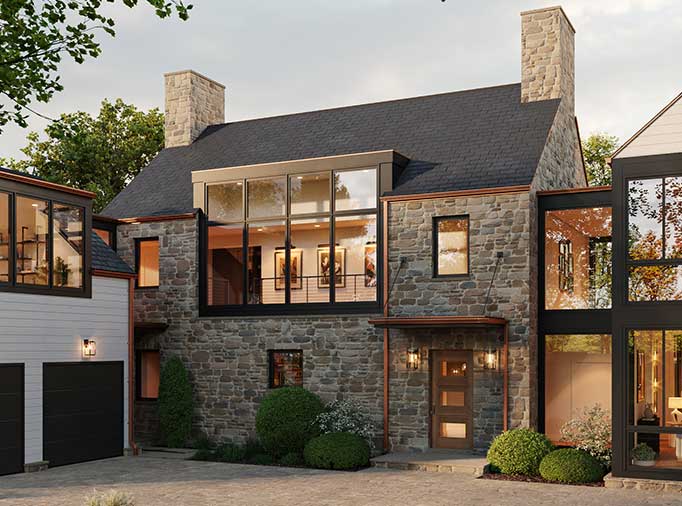January 2023 | General
Modern transitional home design is the perfect confluence of contemporary and traditional styles.
Defining Modern Transitional Style
While the concept may be new to many homeowners, modern transitional design first appeared in the 1950s. Designers and their clients, rebelling against the stark minimalism of what would come to be known as “mid-century modern,” began to blend more traditional elements into contemporary spaces, creating a design style that felt both fresh and timeless. In the decades since that period, the term modern transitional has come to mean the thoughtful mixing of both traditional and contemporary design aesthetics. Achieving modern transitional means striking a careful balance between comfort and sophistication, a place where traditional and contemporary styles fuse in an effortless, elegant way. Popular furniture brands such West Elm, Room and Board and Pottery Barn have perfected the soul of this style.
Spotting Modern Transitional Homes
There are a few telltale signs of a modern transitional home, such as an overall monochromatic, muted color scheme. Darker, warmer colors—often wood-tones—are reserved for accents. Minimalism still reigns supreme in modern transitional design but without compromising the character of the home. Unlike strictly modern décor, the emphasis is on comfort, particularly for seating and sleeping.
Introducing the Hampden Model
Classic Homes of Maryland has recently introduced the Hampden, a redesign of one of our core models—the elegant center-hall colonial. This new modern transitional design includes a streamlined elevation, an open floorplan and architectural elements indicative of this style.
With exterior details simplified, this renewed model features a monochrome exterior in black and white with rich brown accents. A dark woodgrain, Cubist-form garage door (with optional smoked glass), oversized brick, and white and light gray EIFS (exterior insulation and finish system) complete the look. The exterior focuses on the linear—horizontal overhangs and oversized fixed windows with lights dividing the vertical panels. Metal-encased windows replace the traditional smaller window/shutter combination to which we had all become accustomed.
Large, modern front doors feature symmetrical, horizontal glass rectangles, for example, or no windows at all, disrupting the traditional paneled doors. Instead, the elegant grain of the wood makes these large entry doors spectacular and inviting.
Bringing Modern Transitional Indoors
Traditional design can sometimes feel fussy, and contemporary décor can feel cold and impersonal. Transitional interiors, if done right, can bring out the best of both styles. At its best, a modern transitional aesthetic combines curved and straight lines with uncluttered, polished, interior spaces—a seamless transition between styles.
Adding architectural features to the design of your new modern transitional home will make a great impact in creating the desired look and feel. Mid-century-style floors made of natural wood adds texture to any room in the home. Painting window trim in black provides a strong contrast against neutral wall colors. Because black is a classic color, it works well with both modern and traditional furniture and accessories. And wall paneling—one of the top décor trends of 2022—is an easy way to add texture, depth and interest to walls without cluttering the space.
Infuse Modern Transitional into Your Home
Here are suggested ways to infuse modern transitional details into your home from some of the country’s top designers.
- Paint the walls in soft tones.
- Choose tonal upholstery (fabrics made from different shades of the same color).
- Invest in select pieces that embody the modern transitional design—for example, an antique dining table and a modern architectural light fixture above it.
- Keep accessories to a minimum to create an uncluttered look.
- Avoid vibrant patterns and loud prints.
- Introduce various textures to your surfaces and select accessories such as wood, glass, lacquer, metal, rattan or bouclé fabric.
- Select large, impactful artwork and avoid an arrangement of small pieces.
Modern transitional home design moves interestingly through time while incorporating touches of contemporary—even futuristic—style. As a result, the aesthetic can feel more current than retro, bringing both elegance and warmth to a family home.
You can find other examples of modern transitional design in our Portfolio Collection.



